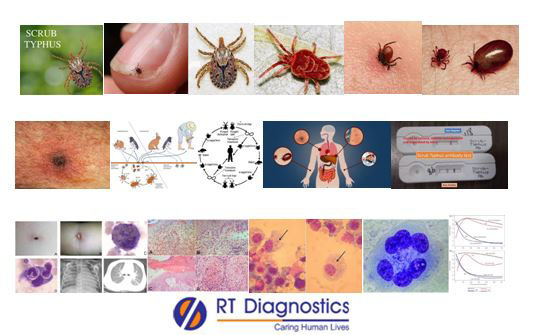Scrub Typhus Antibody:
Why Scrub Typhus Antibody Test?
CLINICAL INFORMATION
Typhus is a disease caused by Rickettsia or Orientia bacteria, transmitted by infected mites, fleas or lice. There are 3 main kinds of typhus, each caused by different bacteria. Murine typhus (transmitted by infected flea bites), Epidemic typhus (transmitted by infected body lice bites), and Scrub typhus (spread by infected chiggers).
Scrub typhus is also known as bush typhus, mite typhus, jungle typhus etc. It is an endemic disease in certain parts of the world. This is called scrub typhus because it initially occurred in areas of scrub vegetations, where rodents (vector) live. Humans are accidental hosts of this zoonotic disease. It is caused by a bacteria called Orientiatsutsugamushi (previously called Rickettsia tsutsugamushi). It is a gram-negative alpha – proteobacterium of the family Rikettsiaceae. It is a larval mite-borne infectious disease, transmitted by species of trombiculid mites (bite of a larval mite also called as “Chiggers” – particularly Leptotrombidiumdeliense. This disease is transmitted through bites of infected chiggers (larval mites). The adult mites have 4 stages of the life cycle – egg, larva, nymph and adult. The larva of the mite is the only stage (nymph and adult mites do not feed vertebrates) that can transmit the disease to humans and vertebrate animals. The incubation period is around 10 days. Clinical manifestations include signs and symptoms of morbilliform rash, maculopapular rash, plantar and palmar erythema, eschar scar, punched out lesions, mucous membrane lining of the eye (conjunctiva), sweating, blood-shot eyes, fever, chills and rigours, headaches, body aches, vomiting, diarrhoea, enlarges lymph nodes, lymphadenopathies, leukopenia, abnormal liver function, splenomegaly, hypotension, muscle pain, diffuse myalgias, rashes, GI symptoms, haemorrhage, intravascular coagulation, DIC, myocarditis, pneumonitis, mental changes (CNS symptoms ranging from confusion to coma) i.e like CNS dysfunction, delirium, seizures, encephalitis etc. Untreated chronic cases may cause complications such as interstitial pneumonia, pulmonary edema, congestive heart failure, circulatory collapse, acute renal failure, meningoencephalitis, and death. The clinical diagnosis which includes mainly the travel history and clinical investigations (eg. to inspect for hallmark features is characteristic black eschar – due to infected larval mite bite i.e“Chiggers” and/or punched out lesions – skin ulcers that become dark in the centre etc). Laboratory diagnostic tests include the Weil-Felix test, indirect immunofluorescence assay (IFA Method), ELISA (serological testing), immuno-chromatographic tests, cell culture, PCR etc. Other tests include CBC, differential count (leukopenia), imaging studies etc.

General Instructions:
Sample Requirement: Specimen - Blood sample collected from the vein. Test Preparation: None.
NOTE - Sample for specimen collections may vary based on the patient’s condition/cases according to the patient’s presenting complaints/signs or symptoms:
SPECIMEN REQUIREMENT (Special or Rare Cases) - As instructed and guided by Physician / Clinician / Pathologist / as per Laboratory’s requirements, according to procedures and protocols.
This Multi-Specialty Clinical Referral Laboratory RT DIAGNOSTICS provides precise and accurate tests with an extensive range of testing services to the medical centres to help in the diagnosis and identification of pathology in the test specimens for infectious diseases and also to evaluate the function of organ systems of the patient. It prevents further complications and helps to stabilize and restore health to near normalcy at the earliest without delay.



